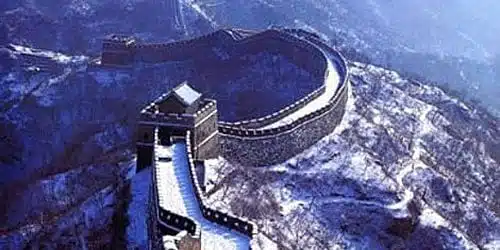
“…I think you have to conclude that this is a great Wall and that it was built by a great people. It is certainly a symbol of what China in the past has been and what China in the future can become. A people who could build a wall like this certainly has a great past to be proud of… and… must also have a great future.”
— US President Richard Nixon on his historic state visit to China, 1976
Thirty-five years later, the Western world finds itself still confronted — now with ever-increasing urgency — with the looming monolith that is its perception of China and the Chinese culture. For many, the similarly monolithic Wall is the one point of certainty, the place where visiting leaders are photographed, events are kicked off… and, inevitably, clichés are born.
Westerners know the Wall is great, even if it isn’t necessarily visible from space after all; but they also sometimes wonder, when they stop to think of it, at the dichotomy between the imaginative magnificence of the achievement and the patent absurdity of it (when even Disney points out — with suprising accuracy — that it never worked very well as a defensive fortification, you know you’re on shaky ground).
Carlos Rojas’s deceptively compact cultural study suggests convincingly that the search for meaning in the Wall lies neither with the iconic imagery nor the literal structure itself, but somewhere in the gaps between, where imagination can run rampant — and frequently has. As it turns out, investigating the many and varied symbolic uses of a wall — the tensions between the need to protect and imprision, to guard against and to tear down, to blazon forth and to shut out — provides a very simple and natural key to opening up the Chinese culture as a whole.
In the West, the Wall = China’s greatness shorthand caught on early, to the extent that the case for labelling a Marco Polo fraud rested heavily on his never mentioning it in his writings — when in reality, as Rojas points out, he probably simply didn’t think the simple earthen fortifications he would’ve seen at that time worth mentioning. The ‘magnificent, huge and admirable’ (vide 17th-century cartographers) monolith begins to break down almost immediately upon closer inspection: What we now call ‘The Great Wall’ is in fact the surviving remnants of several wall-building projects over many centuries. The familiarly imposing stone edifice that Disney’s Mulan defends and Superman rebuilds — and that the Chinese government has embraced as their face to the world — is actually a comparatively recent development, circa the 18th-century Ming dynasty.
Meanwhile, the architects — and later, the guardians — of this magnificent achievement were distinctly ambivalent about it. The wall that “…leaps over the cold moon in the desert mountain pass… while the other end stretches into the hearts of the children of Xia and Hua” has actually shifted both physical and symbolic purpose constantly, as the Chinese have struggled to define who and what they are against the Great Elephant in the Room. What emerges finally is a restless kaleidoscope of attitudes, ideas and influences, a cultural phoenix, as some Chinese scholars have dubbed it, endlessly reborn as each entity appropriates it for its own particular needs.
The process becomes steadily more fascinating to the reader as it enters living memory; the usefulness of the Wall to a Communist ideology would alone be worth the price of admission. The Maoists’ Long March of ‘twenty thousand li‘ drew legitimacy naturally from the Wall of ten thousand li; thus, “if you haven’t been to the Wall, you are not a real man!” The China that resulted has ever since industriously built walls — against AIDS, against undesirable influences on the Internet — that revive the tension of the concept.
Bear in mind, though, that this is foremost a scholarly study; the intent, according to the promotional material, is to ‘map out a provocative new framework for understanding’ the subject — albeit it also includes a little ‘How to Get There’ appendix for tourists, an unexpectedly appealing populist touch. As a writer Rojas is a good technical stylist rather than — well, not exactly rather than a readable one; he assuredly knows his subject well, and without overt pretension. He does, however, have us questioning the very existence of the ‘Wall’ as a concept before the end of the Prologue. Clearly, he is not an academic to be trifled with.
Even within academia, though, the insistence on explaining and assigning specific meaning, to every concept presented, often using what sound like ivory-tower buzzwords (‘In other words…’ becomes something of a mantra), creates a sort of literary inability to see the forest for the trees at times — especially in the earlier chapters, in which the reader is liable to be almost totally dependent on the author for context. A disconcerting habit of using wholly unrelated anecdotes to illustrate his points about the Wall adds to the fragmented effect.
It’s a bit of a shame really, because the topic is an important one for a broad cross-section of readers, and if this reviewer’s experience is anything to go by, it’s very possible to pick up this book out of a vague sense of knowing all about The Wall, and then finding oneself not only fascinated by the subject, but eager to explore further.
